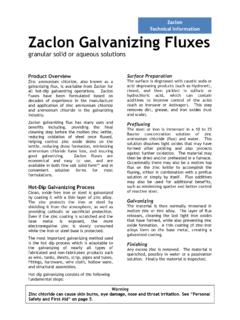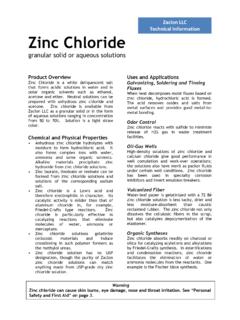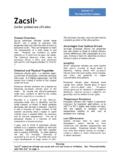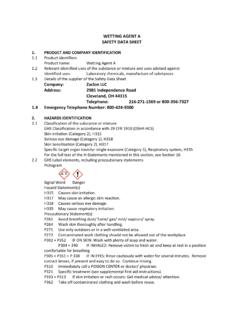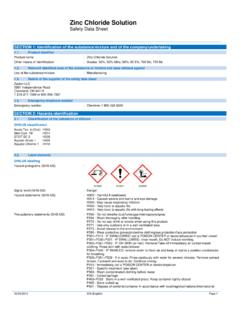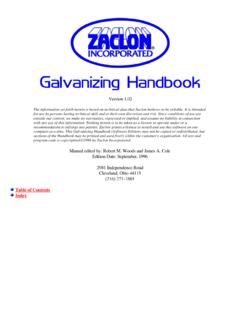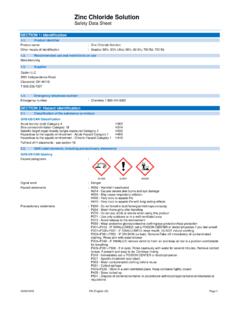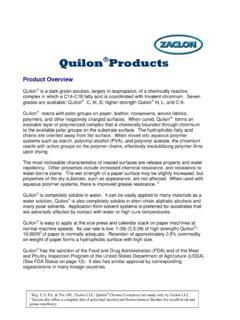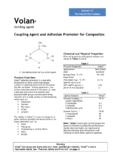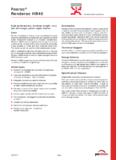Transcription of ZINC CHLORIDE - ZACLON
1 zinc CHLORIDEG ranular Solid and Aqueous SolutionsZinc CHLORIDE is a white deliquescent salt that forms acidic solutions in water and in polar organicsolvents such as ethanol, acetone and ether. Neutral solutions can be prepared with anhydrouszinc CHLORIDE and acetone. zinc CHLORIDE is available from ZACLON , Inc. as a granular solid, or in theform of aqueous solutions ranging in concentration from 50 to 70%. Solution color is water white tolight PROPERTIES! Anhydrous zinc CHLORIDE hydrolyzes with moisture to form hydrochloric acid. It also formscomplex ions with water, ammonia and some organic solvents. Alkaline materials precipitatezinc hydroxide from zinc CHLORIDE solutions .! zinc laurate, linoleate or resinate can be formed from zinc CHLORIDE solutions and solutions ofthe corresponding sodium salt.! zinc CHLORIDE is a Lewis acid and therefore electrophilic in character.
2 Its catalytic activity ismilder than that of aluminum CHLORIDE in, for example, Friedel-Crafts type reactions. Zincchloride is particularly effective in catalyzing reactions that eliminate molecules of water,ammonia or mercaptans.! zinc CHLORIDE solutions gelatinize cellulosic materials and induce crosslinking in such polymerformers as the methylol AND APPLICATIONS! Galvanizing, Soldering and Tinning Fluxes: When heat decomposes moist fluxes based onzinc CHLORIDE , hydrochloric acid is formed. The acid removes oxides and salts from metalsurfaces and provides good metal-to-metal bonding.! Odor Control: zinc CHLORIDE reacts with sulfide to minimize release of H2S gas in wastetreatment facilities.! Oil-Gas Wells: High-density solutions of zinc CHLORIDE and calcium CHLORIDE give goodperformance in well completion and work-over operations; the solutions also have merit aspacker fluids under certain well conditions.
3 zinc CHLORIDE has been used in specialty corrosioninhibitors and invert emulsion breakers.! Vulcanized Fiber: Water-leaf paper is gelatinized with a 72 B zinc CHLORIDE solution is lesstacky, drier and less moisture-absorbent than caustic reclaimed rubber. The zinc CHLORIDE notonly dissolves the cellulosic fibers in the scrap, but also catalyzes depolymerization of theelastomer.! Reclaimed Rubber: Rubber reclaimed from natural, styrene-butadiene rubber (SBR), andmixed scrap with 70 B zinc CHLORIDE not only dissolves the cellulosic fibers in the scrap, butalso catalyzes depolymerization of the elastomer.! Textile Finishing: zinc CHLORIDE induces cross-linking in such polymer formers as the methylolureas. zinc CHLORIDE is a more active catalyst than magnesium CHLORIDE and almost as active aszinc nitrate. It does not contribute to resin yellowing on white goods and has little effect on dyeshades in tinted materials.
4 zinc CHLORIDE solutions induce cross-linking between cellulosics anddurable-press resins, such as those based on imidazolidone -- for example:dimethyoldihydroxyethyleneurea (DMDHEU). ZACLON , Inc. zinc CHLORIDE Solution has a lowconcentration of color-inducing metal-ion contaminants. The textile grade is used as a catalystin resin systems that impart a durable-press or wash and wear finish to cotton and cotton-synthetic blend fabrics. zinc CHLORIDE 50% Solution also serves as a high quality mercerizingagent for : zinc CHLORIDE CAUSES SKIN & EYE BURNS. See PersonalSafety and First SHEET! Liquid Fertilizer: zinc CHLORIDE may be used with chelating agents for a micronutrient in liquidfertilizers.! Dry Cell Batteries: zinc CHLORIDE acts as moisture absorbent for the ammonium chlorideelectrolyte and as corrosion retardant for the cathodic zinc casing. Organic Syntheses: Zincchloride absorbs readily on charcoal or silica for catalyzing acylations and alkylations byFriedel-Crafts synthesis.
5 In esterifications and condensation reactions, zinc CHLORIDE facilitatesthe elimination of water or ammonia molecules from the reactants. One example is the Fischeridole CHLORIDE SOLUTION PROPERTIESSOLUTION GRADE50% , Baume units, 16 oC (60 oF) % as So3 % iron as Fe % % as CaCl2 % as Mn % WhiteWater WhiteWater WhiteWater WhiteBasicity as ZnO % %No testno Heavy Metals (Cd,Pb,Cu) % CHLORIDE , GRANULAR PROPERTIESZinc CHLORIDE (ZnCl2) water soluble %> minimumAmmonia as ammonium CHLORIDE (NH4Cl) % MaximumWater insoluble matter (basic zinc CHLORIDE ) as ZnO % MaximumTotal iron as Fe ppm10 Total heavy metals (Cd, Pb)20 ColorWhiteMolecular point C318 oC604 oFBoiling point 760 mm Hg ( kPa)756 oC 1393 oFDensity 25 oC (77 oF) g/cm3 (Mg/m3) 180 lb/ft3 Solubility in water 25 oC (77 oF) g/100 g solution81 Product Bulk Density Lb/ft3loose 100 packed 110*The above tables give typical properties based on historical production performance.
6 ZACLON , Inc. does not make any express orimplied warranty that these products will continue to have these typical AND HANDLINGM etal drums of granular zinc CHLORIDE should be stored, tightly closed, in a warm 10-24 oC (50-75oF) dry place, protected from direct sunlight. Because anhydrous zinc CHLORIDE readily absorbsmoisture, an inventory turnover rate of about 2-3 months is recommended to minimize thepossibility of caking. Drums of zinc CHLORIDE solutions should be stored with the bung at the top tominimize leakage, and drums should never be emptied by air storage may be necessary for 70 Baume Technical and 72 Baume Technical zinc chloridesolutions to avoid freezing. These grades are also shipped in insulated tank cars equipped withsteam coils. If the load freezes in transit, it can be thawed by connecting the plant steam line to thetank car coils. Freezing and thawing will not affect product OF CONSTRUCTIONC aution should be exercised in selecting materials for use with zinc chlorides.
7 Steel tanks are notsatisfactory for storage of zinc CHLORIDE solutions . For storage at normal temperatures, rubber-linedsteel tanks or fiberglass-reinforced polyester tanks are recommended. Small polyethylene orpolypropylene tanks can also be HAZARDSZinc CHLORIDE is an acidic material and causes skin and eye burns. The principal hazard is to theeye, since even brief contact with zinc CHLORIDE in water may produce permanent damage. Deaths,in which severe damage occurred to the esophagus and pylorus, have been known to occur fromswallowing zinc Department of Labor has ruled that an employee's exposure to zinc CHLORIDE fumes in anyeight-hour work shift of a 40 hour week, shall not exceed a time weighted average of 1 mg/m3 of air(29 CFR ) Air PRECAUTIONSDo not get zinc CHLORIDE in eyes, on skin or clothing. Do not take it internally. Avoid inhaling mist,dust and fumes. Keep container closed. Use with adequate ventilation.
8 Wash thoroughly of the eyes and skin can be minimized by wearing chemical safety goggles and rubbergloves. Additional protective equipment, such as transparent face shield, rubber gauntlets, rubberpants and jacket, and rubber shoes may be desirable where there is a high probability of contactwith concentrated solutions of zinc AIDIn the event of contact, immediately flush eyes or skin with plenty of water for at least 15 minutes,while removing contaminated clothing and shoes. Call a physician. Wash clothing before inhaled, remove to fresh air immediately. If not breathing, give artificial respiration, preferablymouth to mouth. If breathing is difficult, give oxygen. Call a swallowed, give large quantities of water or milk. Do not induce a physician. Never give anything by mouth to an unconscious , Inc. ships zinc CHLORIDE granular in 440 lb.(200 kg) steel drums with a separate polyethyleneliner.
9 , and in plastic 55 lb. (25 kg.) bags, palletized 40 per CHLORIDE solutions are shipped in tank cars, tank trucks and in non-returnable 30 gallon and 55gallon polyethylene CHLORIDE granular is classified a corrosive material (UN 2331) by the Department ofTransportation (DOT). zinc CHLORIDE solution is classified a corrosive material (UN 1840) by ZACLON placing orders or requesting additional product information, please contact usas shown THE INTERNET: Customer Service: PHONE:Toll Free In Continental : (800) 356-7327 From outside United States: (216) 271-1715BY MAIL: ZACLON , Service2981 Independence RoadCleveland, Ohio 44115 The information set forth herein is furnished free of charge and is based on technical data that ZACLON ,Inc. believes to be reliable. It is intended for use by persons having technical skill and at their own discretionand risk. Since conditions of use are outside our control, we make no warranties, express or implied, andassume no liability in connection with any use of this information.
10 Nothing herein is to be taken as a licenseto operate under or a recommendation to infringe any to changing governmental regulations, such as those of the Department of Transportation,Department of Labor, Environmental Protection Agency and the Food and Drug Administration,references herein to governmental regulations may be superseded. You should consult and follow thecurrent governmental regulations, such as Hazardous Classification, Labeling, Food Use Clearances,Worker Exposure Limitations and Waste Disposal Procedures for the up-to-date requirements for theproducts described in this literature.
